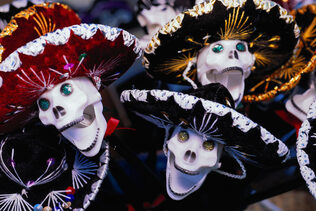Today is Hallowe'en and, although most people associate it with witches, I want to take a moment to briefly reflect on its other meanings. Hallowe'en began as a pre-Christian Celtic festival, Samhain. This marked the end of summer (in the Northern hemisphere) and the beginning of the long dark nights of winter. At Samhain, the veil between this world and the next was thinner, allowing the dead to pass through and visit. Fires were lit to keep away evil spirits and food was placed out for the souls of loved ones.
Christianity took over this ancient custom and merged it with its own custom of All Saints' or All Hallows' Day (November 1st) and All Souls' day (November 2nd). The term Hallowe'en actually derives from All Hallows' Eve. All Saints' Day was a day of remembrance for saints and martyrs who did not have their own day and All Souls' Day was a day of remembrance for loved ones who had died.

While Hallowe'en has mostly lost its original meaning, there are still places where the customs on October 31st and the following two days are truer to the original forms. In many European countries, families visit cemeteries, leaving flowers and sometimes having picnics.
In Mexico, Dia de Meurtos or Day of the Dead involves visits to graveyards to honour the dead through building altars, leaving gifts and food and drink for them. The Portugese took the Catholic customs with them to Goa in India and it is now customary on All Souls' Day for lunch to be offered to the poor. Families may also visit graveyards to decorate the graves of their lost ones.
The Phillipines also have a version of Dia de Muertos when whole families may spend a night or two at the grave, eating, drinking, singing and playing cards - generally having a party with their deceased! The relationships with their dead still live.
Comments